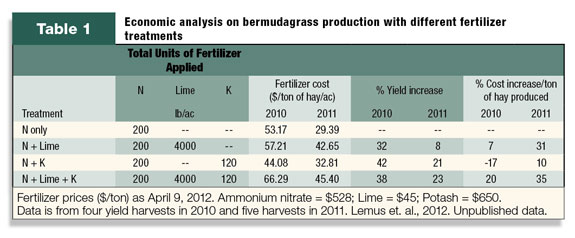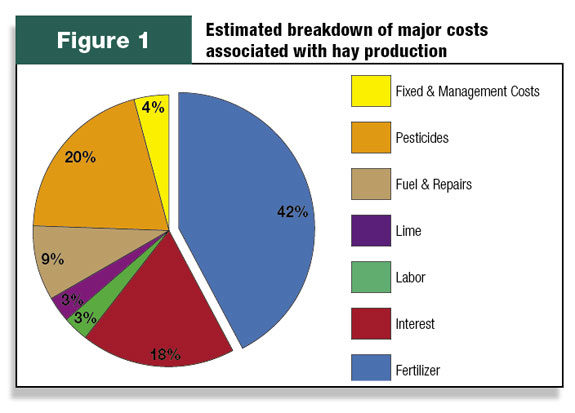Many hay producers do not soil test and only some of their fields have an optimum pH (greater than 6.0 and less than 7.0).
Most soils have a pH ranging from 5.2 to 5.8.
Do not neglect the soil pH since it could affect soil tilth, root development and create nutrient imbalances.
Low pH can affect fertilizer use efficiency and reduce Nitrogen (N) uptake by 30 to 35 percent, phosphorus (P) by 45 to 50 percent and potassium (K) by 10 to 15 percent. This translates into an economic loss of fertilizer dollars. Therefore, many producers do not soil test, but still fertilize their soils regularly to avoid this expense.
Lime is a key ingredient to improving soil fertility. Since water is required for lime to react with the soil, effects of a lime application will be slower in a dry soil.
It often takes six months to a year before a response can be measured even under perfect conditions. However, a response may be observed within weeks of the application when soil pH is extremely low.
In areas where it is needed, it is important to apply lime immediately after the growing season or crop removal to allow lime to react, correcting soil pH before the next growing season.
Even though it is best to incorporate lime whenever possible, it is still important to surface-apply lime to correct the soil acidity problem in established pasture and hay fields, and correcting pH in the top two to three inches of the soil can have a positive effect on forage production.
The reactivity time also depends on the type of lime used. Liming materials differ widely in their neutralizing powers due to variations in the percentage of calcium and magnesium.
The coarseness of the liming material will also influence how fast the lime will react. In other words, the finer the liming material, the greater the surface area, resulting in faster reactivity, but not necessarily meaning a longer neutralizing effect.
Hay fields and pastures should be treated differently in terms of when to apply fertilizers, especially N – even when soil test results are the same.
To make hay, there is the need for good nutrition to maximize the productivity and quality of the final product. There are three major nutrients that have an impact on hay production and constitute a real cost to producers: P, K and N.
In the spring, phosphorus is a crucial nutrient in promoting the development of new roots and tillering. Phosphorous could be applied to a hay field at any time of the year since it is very stable and available to the plant when needed.
That is not the case when applying P to annual crops – it should be applied before planting. The flexibility on application times could benefit producers in obtaining P during the off-peak season when prices and application rates might be lower. If P levels are low, it could affect hay production and allow only 40 to 60 percent of total hay production.
The development of a good root system will allow extracting nutrients from restricted areas and increase nutrient uptake.
Depending on the soil type, hay removes from eight to 16 pounds of P per ton of hay produced per acre. Optimum levels of P can also increase the magnesium and calcium leaf concentrations, which enhances photosynthetic activity.
Nitrogen use efficiency could also be significantly increased by P fertilization. Optimal soil phosphorus level in your soil should be between 30 and 40 pounds per acre.
Potassium is a very important nutrient to allow plants to survive in cold weather and sustain productivity during drought stress. It is involved in many metabolic processes in the plant. There is a very low environmental risk with K applications.
The major inefficient use of K is a phenomenon called “luxury consumption.” During this phenomenon, forage crops will take up more K than is required for optimum growth.
To avoid luxury consumption, K should be applied on two or more split applications during the hay season. A 60-40, 50-50 or 40-60 split application could be ideal depending on the needs of the crop being grown.
Potassium, on the other hand, should be applied at the removal rate and based on soil test recommendations. Warm-season perennial crops could remove from 30 to 60 pounds of K per ton of hay produced.
Nitrogen is usually the most limiting element in hay production. Nitrogen is a major nutrient involved in chlorophyll development for photosynthetic activities, yield production and forage quality (crude protein).
Nitrogen, however, requires some timing and proper manipulations to get good yields and reduce losses. Bermudagrass hay production requires 150 to 200 pounds N per acre. Splitting N applications will reduce the risk of leaching and volatilization losses as well as the risk for nitrate toxicity.
The most efficient way to fertilize a hay field is to split-apply N based on the expected yield of the next growth. The actual rate should be 50 pounds N per ton of expected hay yield.
Research has shown that splitting N applications can increase N use efficiency 25 to 35 percent and yields by 5 to 10 percent. Fertilizer should be applied at least three days after cutting hay. Allowing the plants to recover and have some new green leaves will increase photosynthetic activity and will increase nutrient uptake.
All the common N fertilizer products (ammonium nitrate, urea, urea ammonium sulfate, urea ammonium nitrate solution) work well. If urea or UAN are used, applying them right before rain will help to minimize N volatilization loss.
Manure such as poultry litter could also be an excellent choice for hay fields, especially with current high fertilizer prices if the producer could have access to it. Be aware that if manure is used as the sole source of N for a hay crop, excess P and K will likely be applied over time.
It is important to know that only 50 percent of the N might be available the first year of application. Applying poultry litter between cuttings also provides other management strategies. This will reduce possible P runoff and K luxury consumption by the grass.
This also avoids storing and spreading the manure in the fall when manure nutrient use efficiency is generally lower because grasses such as bermudagrass and bahiagrass are going dormant. This could also increase the economic return from nutrient utilization compared to late-fall applications.
Be careful not to apply too much manure – this will smother the hay and allow excessive moisture accumulation that could cause fungal diseases such as leaf spot disease.
No more than two (surface-applied) to four (incorporated) tons of manure per acre per year should be applied during the growing season.
Apply as soon after harvest as practical to reduce potential injury to regrowth. Test the poultry litter for nutrient content and follow regular soil testing (every year) to monitor for excess nutrients resulting from overfertilization with poultry litter.
A two-year ongoing study at Mississippi State University is focusing on the effect of lime, K and N in hybrid bermudagrass production. The study is being conducted on six hybrid bermudagrasses and simulates common practices observed by producers across the state.
The soil pH at the beginning of the study was 5.5 and K soil nutrient content was in the low level. Nitrogen (ammonium nitrate) was applied alone to simulate no soil testing and then N was applied in combination with lime, potassium and the combination of both lime and K.
Nitrogen was applied at the rate of 200 pounds N per acre in split applications of 50 pounds N per acre. Lime was applied at a rate of two tons per acre in split applications of one ton per acre.
Potassium was applied at a rate of 120 pounds K per acre in 50-50 split applications. Total yields were higher when nitrogen was applied in combination with lime, K or lime and K.

There was a 32 percent, 42 percent and 38 percent yield increase in 2010, respectively. Economic analysis indicated that the fertilizer price per ton of hay produced was lower when lime and K were applied in 2010, but the same benefits were not observed in 2011 where yield increases compared to N only were not as high as in 2010 (Table 1).
This indicates the importance of yearly soil testing to balance nutrient need, increase hay production and replenish nutrients removed during the growing season.
Soil testing is strongly recommended to determine lime and fertilizer needs. A good soil testing program can help identify problems on specific hay or pasture fields, save money on unnecessary fertilizer applications and improve yields through increased fertilizer use efficiency.
A good soil testing program depends on how the sample is collected. It is recommended to break large fields in 10- to 15-acre sections and collect 10 to 15 random core soil samples to a depth of six inches.
Mix the soil cores and collect about one pint for analysis. Contact your local county extension office to obtain information sheets and soil sample boxes. FG
—Excerpts from Mississippi State University Extension Service












